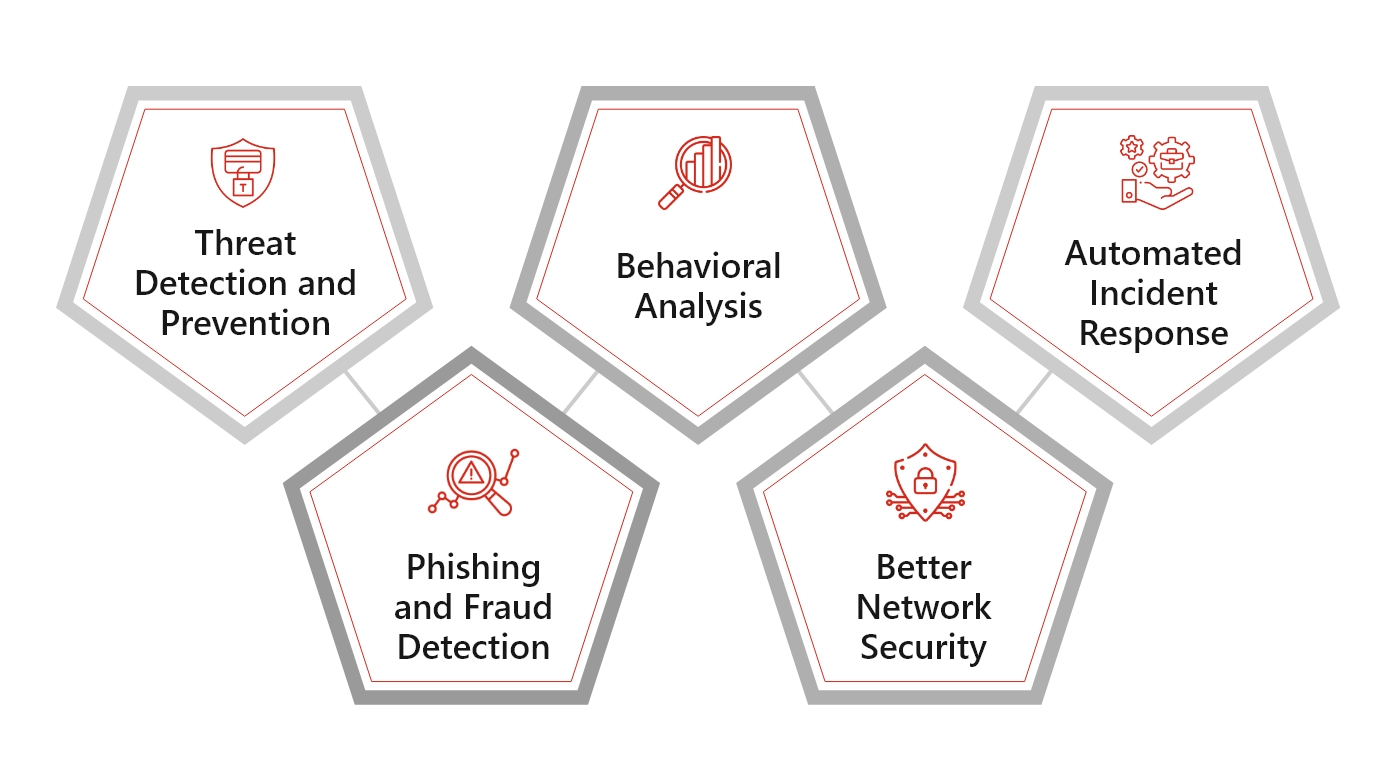With technology marching forward daily, cyber threats are getting craftier every minute, creating a growing challenge for businesses to safeguard their critical assets. AI emerges as a potent ally in this ongoing struggle against malicious actors, simplifying threat detection and helping companies make quick remediation.
Around 69% of organizations acknowledge artificial intelligence’s (AI) crucial and essential role in addressing and combating cyber threats. Let’s look at how AI in Cybersecurity helps businesses win a significant edge in preventing future attacks.

AI systems analyze large real-time datasets, including videos, chat, emails, etc., to detect patterns and anomalies, indicating potential security threats. Suppose cybercriminals are one step ahead in manipulating the code. In such a scenario, machine learning can learn from their historical data and identify new variants, even if malicious threats are hiding in plain sight within the code.
Scanning historical data and current threat intel helps businesses in predictive analysis, helping them identify critical vulnerabilities, prioritize which ones to address first and optimize resource allocation where needed most. Currently, 63% of breaches can be identified in minutes when AI is applied.
Unlike traditional Cybersecurity, which heavily relies on signature-based detection, AI-powered behavioral analysis encompasses user activity, network traffic, and system events. It learns and establishes a baseline for “normal” behavior specific to the environment, making this baseline the reference point for identifying anomalies.
Constantly monitoring for deviations from established norms, AI in cybersecurity can detect unusual login attempts, sudden spikes in data access, unauthorized file or system access, and deviations from typical communication patterns. This empowers businesses with early detection, enabling faster responses through automated alerts or containment procedures, ultimately minimizing potential damage.
AI automates incident response by rapidly identifying and containing security incidents to minimize response time and impact. These systems adapt and learn from each incident, enhancing overall security and freeing up security professionals to focus on strategic initiatives and complex investigations. This results in a streamlined process and reduced operational burden, allowing organizations to strengthen their cybersecurity posture proactively.
AI improves phishing and fraud detection using NLP for phishing emails and machine learning for spotting unusual transaction patterns or user behavior. AI-based phishing detection tools help security professionals filter out false positives, allowing them to focus on genuine threats and minimizing the risk of overlooking critical security alerts.
● AI-driven Intrusion Detection and Prevention Systems (IDPS): AI-powered IDPS can identify and respond to network threats in real time, safeguarding networks from unauthorized access and attacks.
● Firewall Enhancement: AI can optimize firewall rules based on network traffic patterns, improving the efficiency of network security
● SIEM (Security Information and Event Management): AI can improve the analysis of security events, correlating data from various sources to identify complex threats.
AI-powered security solutions can be less intrusive and more user-friendly, reducing friction and improving overall security posture. This new paradigm seamlessly blends protection into the fabric of your digital business. One key example is authentication processes, where AI analyzes user behavior, device characteristics, and location data to craft secure yet user-friendly authentication methods. This could mean accessing accounts with a simple fingerprint scan or voice recognition, streamlining the user experience.
Moreover, AI brings a personalized touch to security by adapting to individual needs and risk profiles. Learning from typical usage patterns, it identifies anomalies that may signify suspicious activities, enabling targeted security measures without unnecessary restrictions. The proactive nature of AI extends to threat detection, continuously analyzing user activity to identify and neutralize potential threats before they pose a risk.
More competent password management is another benefit. AI can suggest and update solid and unique passwords across accounts, reducing the risk of password-related breaches and alleviating the burden of memorizing complex combinations. The adaptability of AI is showcased in its ability to dynamically adjust security levels based on context, tightening measures in sensitive scenarios on public networks while relaxing them for trusted activities on personal devices.
Zero Trust Security Models: AI plays a crucial role in implementing and enhancing Zero Trust security models. Zero Trust assumes that no user or system, even those inside the organization’s network, should be trusted by default. AI helps in the continuous monitoring and verification of users and devices.
AI in Endpoint Security: Endpoint protection platforms leverage AI to detect and prevent malware, ransomware, and other malicious activities at the endpoint level. This is especially important as remote work increases the attack surface.
Explainable AI (XAI): As AI systems become more complex, there is a growing emphasis on making AI decisions explainable. In Cybersecurity, understanding why an AI system flagged a particular activity is critical for effective response and decision-making.
Integration of Generative AI: Generative AI is being explored for its potential to create new types of cyber threats and defend against them.
Privacy-Preserving AI: With increasing concerns about privacy, there is a trend toward developing AI models that can analyze and identify security threats without compromising sensitive information. Techniques like federated learning enable collaborative model training without sharing raw data.
As we reflect on the dual-edge impact of AI in Cybersecurity—both as a defense and a weapon—it’s evident that responsible implementation is paramount. The statistics speak volumes, with over half of recent cyberattacks leveraging AI and organizations using AI reporting significantly lower breach costs. The financial benefits are striking, with an average difference of $1.76 million in breach costs.
However, the importance of responsible implementation cannot be overstated amidst these advancements. At iLink Digital, we offer AI-driven cybersecurity solutions designed to operate seamlessly and invisibly, ensuring robust protection for your business without compromising the user experience. Ready to take the following steps toward a more secure digital future?
Check out our AI-driven Cybersecurity Services!


![]()
Etiam magna arcu, ullamcorper ut pulvinar et, ornare sit amet ligula. Aliquam vitae bibendum lorem. Cras id dui lectus. Pellentesque nec felis tristique urna lacinia sollicitudin ac ac ex. Maecenas mattis faucibus condimentum. Curabitur imperdiet felis at est posuere bibendum. Sed quis nulla tellus.
63739 street lorem ipsum City, Country
+12 (0) 345 678 9
info@company.com

